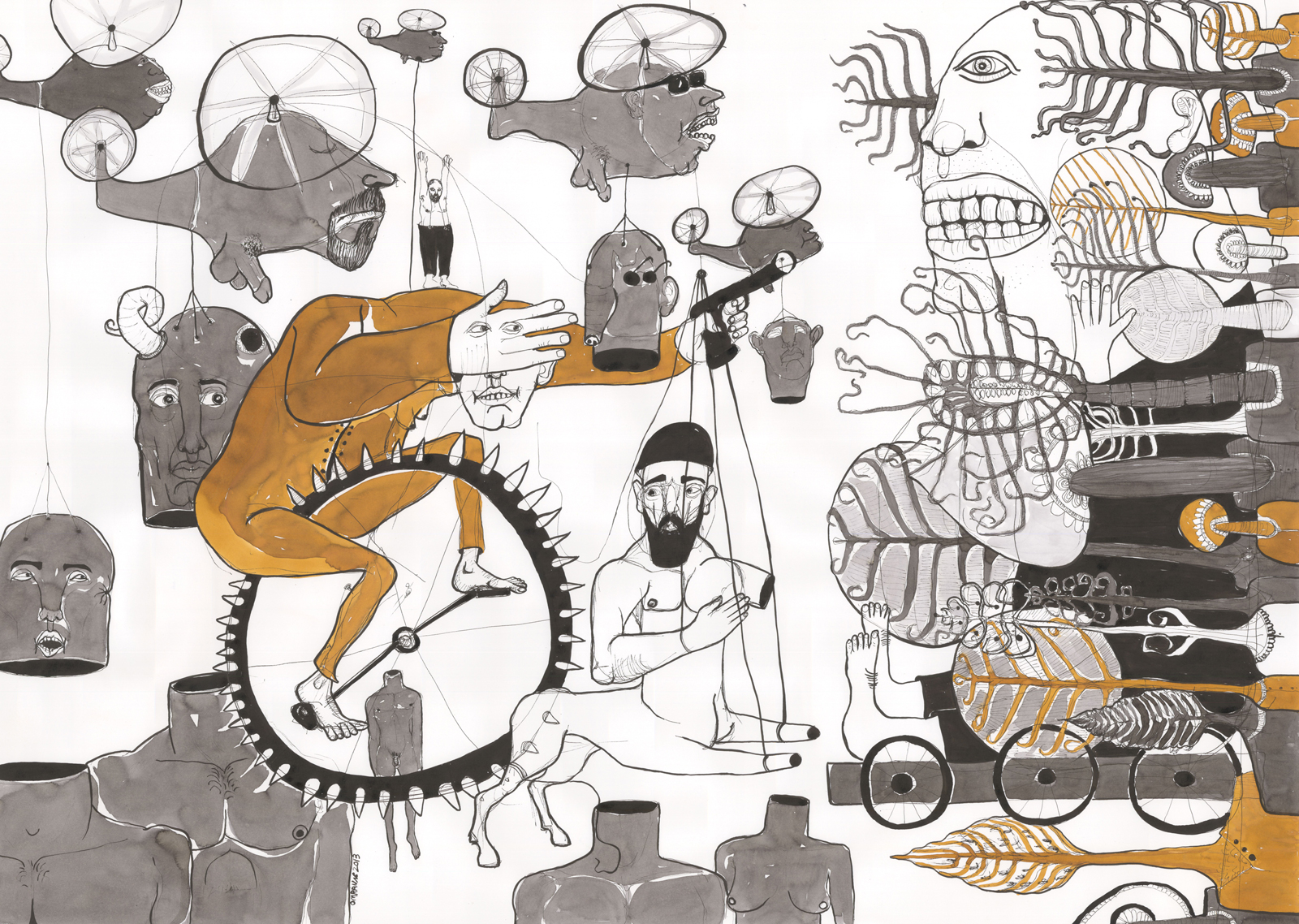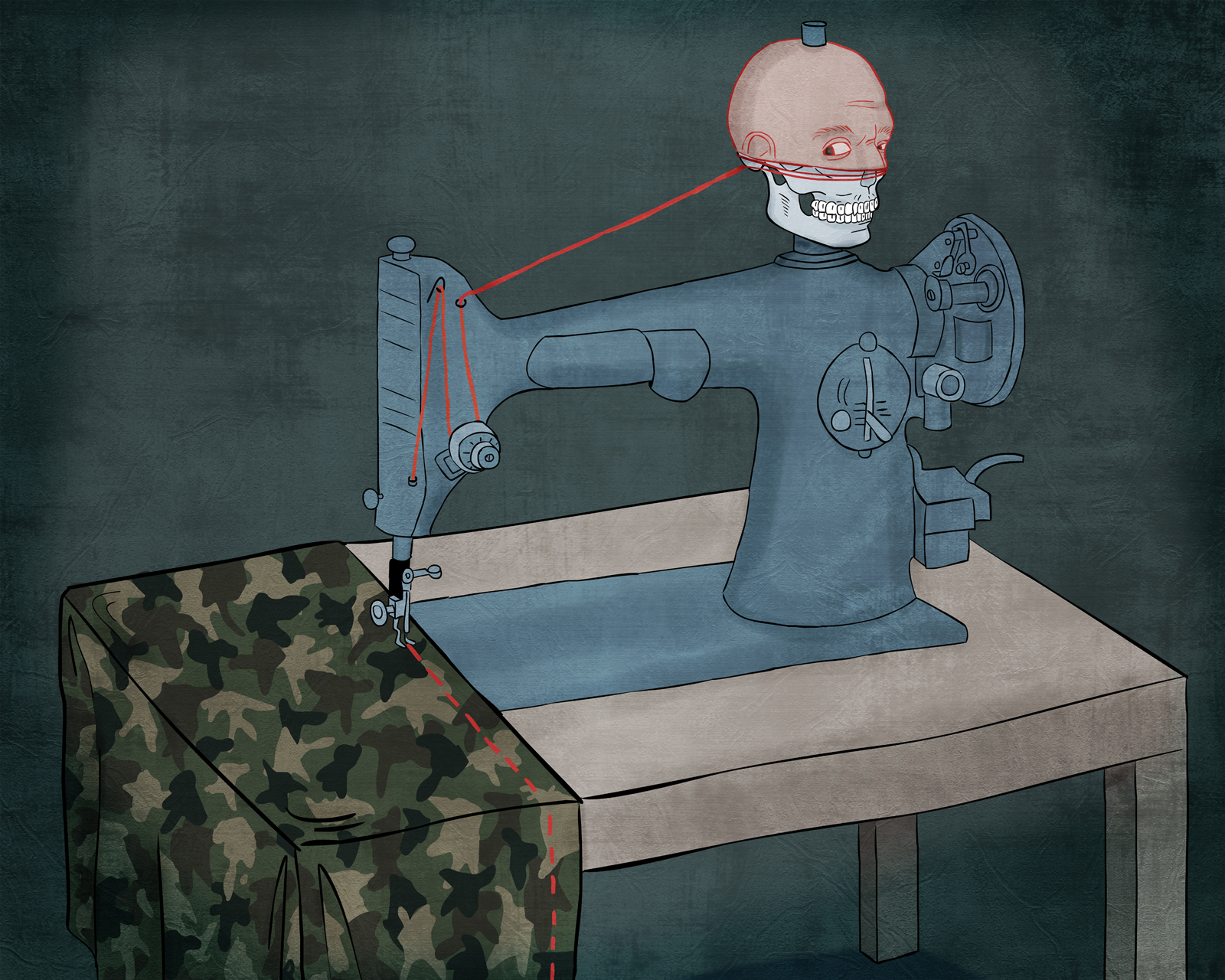In the fables of Aesop and La Fontaine, animals illustrate human virtues and vices: foxes are sly; ants are industrious; asses are often fools. The short fiction of the Syrian writer Osama Alomar uses animals that are also recognizable types (his ants tend to be hard workers too), but the effect isn’t usually charming or edifying. Instead of a comedy of manners, his non-human characters are, like their human models, stuck in a nightmare of dictatorship and social paranoia. Human folly and injustice go all the way down: “A flower planted on the edge of the veranda looked spitefully at another flower inside the house. She asked her companion, ‘Why should that worthless plant be welcomed inside while we are left out under the burning sun to die of thirst?’ ‘She must have known an important flower!’ her friend replied.”
If animals and plants think and act like people, the reverse is also true: human society is governed by the law of the jungle. In Alomar’s tales, the norm of social behavior isn’t justice or civility, but eat or be eaten. Politics is Darwinism in disguise and the only true law is universal inequity. The strongest stories give the lie to the didacticism of older fables, since it isn’t clear that humans (or animals) can learn from their mistakes. As Kafka is reported to have said, “To believe in progress is to believe that there has not yet been any.”
Such grim premises give Alomar’s fiction a vaguely theological flavor. Many stories mention hell as a synonym for reality—that is, a state of never-ending punishment for unknown crimes. His cast of characters is a troop of the damned: pitiable civil servants, interrogators, wife beaters, dictators, child abusers, puffed-up literary men. And the world they inhabit is as grotesque as the visions of Bosch. The most prominent features of Alomar’s landscapes are volcanoes, heaps of garbage, quicksand, and barbed wire, elements that reappear in story after story. This isn’t a realistic depiction of Syria, but the war has made it into a frighteningly prophetic one.
Alomar was already well known in Syria when he left the country in 2008 to join family in the United States. Since then he has mostly worked as a cabbie in Chicago while two collections of short stories have been published in English. (They were selected by their able translator, C.J. Collins, who writes that he collaborated closely with Alomar on the English versions, doing most of them “in the front seat of [Alomar’s] taxi in a Chicago suburb heavy with the ache of immigration.”) Many of these stories were written before the war, but even those written afterward make no explicit reference to the fighting—or indeed to Syria at all. Alomar’s allegories and aphoristic pieces are set in no particular time or place; his characters have no names and there are no historical references. And yet, it’s impossible to imagine these works as written by anyone but a Syrian.
In her preface to his first collection in English, Fullblood Arabian, the writer and translator Lydia Davis suggests that Alomar is working in the venerable tradition of the “very short story” (in Arabic, al-qissa al-qasira jiddan), although his texts could just as easily be called prose poems: most are no more than a paragraph or two; some are as short as one sentence while others stretch out to two or at most three pages. Davis’s thumbnail history of the very short story extends from the animal tales of the Sanskrit Panchatantra (translated into Arabic in the eighth century as Kalila wa Dimna) up through the modern works of Kafka, Bernhard, and the Dutch writer A.L. Snijders. In the Arabic tradition, one finds antecedents in the medieval akhbar, typically concise reports or anecdotes, often humorous, that form the backbone of biographical and historical literature. A more recent precursor is the work of Khalil Gibran, though Alomar’s infernal scenery is a cruel inversion of Gibran’s idyllic landscape of mountains, vineyards, and shepherds.
In Alomar’s stories, as in the older fables (and Disney cartoons), animals can speak and every object is apt to express an opinion. Wall clocks, buckets of water, flags, and lighthouses come alive and noisily assert themselves. Alomar’s fables spring from a moralizing impulse—in his lesser texts, he gives in to it—but they also resist that impulse in interesting ways. A favorite trick is to begin the story from a human perspective and then shift to that of an animal or object, who offers a commentary on the action. In one story, a farmer milks the cow while his wife nurses their baby. We switch abruptly to the cow’s point of view. “Why doesn’t this intruder leave me alone and be content to milk his female!?” the cow thinks to herself. “I want my children to get their fill of my milk. I never saw a man milk his female even once. Is it simply because we’re cows? What kind of slavery is this!” In another story, a musical concert ends, the audience claps, and then we get the hands’ take. Why are we being violently beaten against each other, they wonder. Then, seeing members of the orchestra bow, one hand exclaims, “‘Why are they bowing?’ Trying not to show its pain, the other hand replied, ‘They respect violence!’”
Advertisement
These sudden shifts of position—from human to animal, oppressor to victim—reveal the artifice or impermanence of a state of affairs we take for granted. “I lay on the riverbank enjoying the gentle breezes,” Alomar begins one story. “A few meters from me, a feather, blown violently in every direction, was cursing the storm.” Or again, “The elevator that was going up to the top floor looked at his colleague who was going down to the lowest and called to him disdainfully, ‘You descender!’ But after a while the roles were reversed and so were the names.”
Rather than reassure with universal certainties, Alomar’s fables turn the world into a changeable series of perspectives. Judgment depends on one’s place in the hierarchy—whether you’re up or down makes all the difference—and there’s no place from which to survey the whole. Alomar began writing in this radically perspectival way before the Syrian war started, but his technique seems especially well suited to the realities of a country once famed as a mosaic but which now lies in fragments.
Most readers who encounter Alomar in translation will think of Kafka, whose fables of bureaucratic absurdity have made him an honorary Syrian. And several of Alomar’s parables are unmistakably Kafkaesque. In one, a man wakes from a nap to find himself, inexplicably, in a narrow tunnel with walls made of iron (shades of “Metamorphosis” and also “The Burrow”). After a long struggle, he crawls out of the passage and into the light. When he turns to look at what he’s escaped from, he sees “the barrel of a cannon being raised upward in preparation for firing.”
This kind of coup de grâce, when a story goes from bad to very bad, is another specialty of Alomar’s—it is even the source of his blackest comedy. Again and again in his stories, a promised rescue or moment of respite turns out to be the trapdoor to a deeper circle of hell (the afterlife will be very much like the present, in other words, only worse). Animals and objects don’t provide relief from human cruelty, but rather a refinement or exaggeration, as in “Kicks”:
The two interrogators had left their prisoner curled in a corner of the room, bleeding profusely and shaking in terror. Soon the corner itself administered a kick that sent him tumbling across the room. In this way the four corners went on kicking him back and forth until the roof collapsed on him and finished the job.
Or again, in “Bone Separation,” a story that resonates in the present all too strongly:
The prison guard brought in an enormous pile of bones and said to the prisoner haughtily, “If you can separate the animal bones from the human ones we will set you free immediately.” He went away with a sadistic laugh. The prisoner spent years trying in vain to separate out the bones. Eventually he fell dead over the pile, and his own bones, little by little, were lost among the others.
Alomar has other influences closer to home than Kafka. No doubt the most important is Zakaria Tamer, a native of Damascus now living in London whose surreal allegories are among the most celebrated works of modern Arabic literature. Tamer’s best-known story, “Tigers on the Tenth Day” (the title piece of an English-language collection), is an obvious touchstone for Alomar, an allegory about the reversibility of human and bestial behaviors as well as the debasement of political life in Syria.
The story tells of a tiger removed from his jungle home and put in a cage. A human trainer promises his students that the tiger will quickly be brought to heel: “Watch what will occur between the one who possesses food and the one who does not, and learn.” To eat, the proud tiger soon learns to humiliate himself, mewling like a cat, braying like a donkey, applauding meaningless speeches, and finally eating grass (and liking it). The last line of the story reads, “On the tenth day the trainer, the pupils, the tiger and the cage disappeared: the tiger became a citizen and the cage a city.”
Advertisement
The Assad regime has applied the tiger trainer’s lesson to the Syrian populace. Laying siege to his own cities, Assad has starved his citizenry into submission—or forced them to leave the country. But Alomar’s stories, like Tamer’s, take their distance from this savagery. While full of violence, his fictions are not reports from the frontline. It may be this distance—the abstraction required by allegory—that paradoxically makes them feel so immediate.
One of Alomar’s stories, “The Boot,” can be read as a sly parable of his approach to writing. Only about a hundred words long, it describes a young man who grows up “enjoying the blessings and the paradises of his country.” But one day he decides to travel. As the plane takes off, he is granted his first view of home from above (one of Alomar’s characteristic shifts of perspective). Looking down from the airplane window, the traveler is caught by surprise: “The layout of his country from the air took the shape of an army boot.” Alomar’s fiction works in just this way, taking its distance from things in order to see their truth. While often whimsical on the surface, in aggregate his stories offer a uniquely haunting account of the conflict they never name.
Osama Alomar’s The Teeth of the Comb & Other Stories and Fullblood Arabian are published by New Directions. Syria Speaks is published by Saqi Books.




